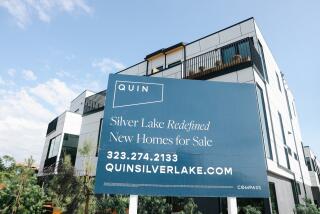More Home Buyers in ’87 Depended on 2 Incomes
CHICAGO — People buying homes in 1987 were more likely than their 1977 counterparts to depend on two incomes to pay the mortgage, while the national median price of a home more than doubled in the period, according to a survey released Wednesday.
The median price of a home in 1987 was $95,000, compared to $44,000 a decade ago, but the survey by the Chicago-based U.S. League of Savings Institutions found no housing affordability crisis.
“There is ample housing available for a wide range of incomes,” said Mike Wilson, associate director of research for the group.
“The national median was $95,000, but that means that 50% of the houses sold for below that,” Wilson said. “That means that people, to some degree, must be willing to move into what they can afford.”
As in 1977, the most expensive of 15 metropolitan areas surveyed by the league in 1987 was the San Francisco-Oakland-San Jose area. The median cost of a home there last year was $169,347, up from $72,000 a decade ago.
The biggest jump in prices in the decade came in the metropolitan New York area, which covers parts of New Jersey and Long Island. The median price of a home there was up 194% to $142,400 from $48,500.
Home Buyers Older
Of the 15 areas surveyed, Pittsburgh had the lowest 1987 median price at $71,500. Houston showed the lowest rate of appreciation among the 15 areas, climbing 56% from $46,900 in 1977 to $73,000 last year.
In 1977, a typical home buyer was 32.4 years old, married and part of a household that included three or more people but depended only on a single wage-earner.
By 1987, that same home buyer was older (37), less likely to be married (74% from 83% in 1977), and more likely to be single (26% from 17% in 1977).
And for the first time, the majority came from a one- or two-person household (53.6% from 45.8% in 1977) and depended on a second wage-earner (54.5% from 47.2%).
The second source of income helped boost the 1987 home buyer’s median income to $46,000, more than twice the $22,700 the 1977 counterpart would have earned.
But the 1987 buyer’s monthly costs skyrocketed accordingly--to $822 to cover the mortgage payment, real estate taxes, utilities and insurance. The 1977 costs were $400.
In 1977, 37% of home buyers committed more than 25% of their income to meet monthly obligations. After reaching a high of 45% in 1979, the percentage of homeowners devoting more than a quarter of their income to housing costs declined steadily to 30.5% last year.
More Single Purchasers
The number of single home buyers was 26% last year, compared to 17% in 1977.
The survey was compiled from data gathered from a sampling of 22,000 loan applications made by homeowners at savings and loan institutions.
“What we’ve found tends to confirm many popular conceptions about both the economy and demographics,” Wilson said. “The baby boomers are graying, they appear to be delaying having families, and they have higher disposable incomes.
“Further, increases in the value of housing tends to follow prosperity. Almost all the metropolitan areas . . . except Houston and Dallas, probably because they’re oil-based economies . . . tended to show significant increases,” he said.
Because the next wave of buyers--members of the what mortgage lenders call the “baby-bust” generation--will be fewer in number, the study predicted prices will moderate.
That, in turn, should make it easier for first-time buyers to enter the housing market at an earlier age than their baby boom counterparts, actually leading to an increase in the nation’s home ownership rates.
THE RISING COST OF HOMES
Median purchase prices for homes in 1987 and 1977 nationally and in 15 metropolitan areas surveyed by the U.S. League of Savings Institutions:
1987 1977 Pct. Area Price Price Change San Francisco $169,347 $72,000 +135% Los Angeles 142,900 65,000 120 New York 142,400 48,500 194 Washington 137,500 68,000 102 Minneapolis 114,000 47,250 141 Chicago 110,000 50,900 116 Baltimore 106,500 47,000 127 Philadelphia 99,000 45,000 120 Columbus, Ohio 88,000 42,000 110 St. Louis 84,600 37,000 129 Miami 78,900 48,500 63 Milwaukee 76,400 42,900 78 Houston 73,000 46,900 56 Portland, Ore. 72,950 32,500 105 Pittsburgh 71,500 37,800 89 National average 95,000 44,000 116
Source: Associated Press
More to Read
Inside the business of entertainment
The Wide Shot brings you news, analysis and insights on everything from streaming wars to production — and what it all means for the future.
You may occasionally receive promotional content from the Los Angeles Times.










